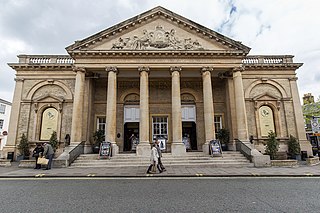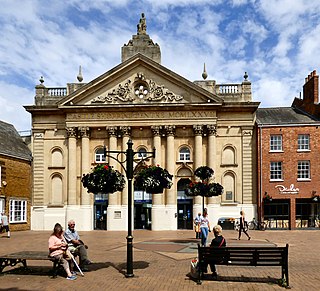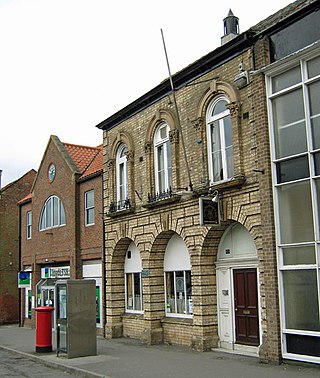
The Corn Exchange is an events and concert venue located in the Market Place in Newbury, Berkshire, England. The structure, which was commissioned as a corn exchange and is now used as an events venue, is a Grade II listed building.

The Corn Exchange is an events and concert venue located on St Paul's Square in the Castle area of Bedford, Bedfordshire, England. The structure, which was commissioned as a corn exchange, is a Grade II listed building.

The Palace Theatre & Grand Hall Complex is a multi-purpose entertainment arena complex in Green Street, Kilmarnock, Scotland. The structure, which was originally opened as a corn exchange, is a Category A listed building.

O2 Academy Edinburgh is an events and concert venue located in New Market Road in Edinburgh, Scotland. The structure, which was commissioned as a corn exchange, is a Category B listed building.

The Corn Exchange is a commercial building on The Payment in St Ives, Cambridgeshire, England. The structure, which is currently used as an events venue, is a Grade II listed building.

Corn exchanges are distinct buildings which were originally created as a venue for corn merchants to meet and arrange pricing with farmers for the sale of wheat, barley, and other corn crops. The word "corn" in British English denotes all cereal grains, such as wheat and barley. With the repeal of the Corn Laws in 1846, a large number of corn exchanges were built in England, particularly in the corn-growing areas of Eastern England.

The Corn Exchange is a commercial building on Fore Street in Hertford, Hertfordshire, England. The structure, which is currently used as an events venue, is a Grade II listed building.

The Corn Exchange is a former commercial building in Reading, Berkshire, England. The structure, which was commissioned as a corn exchange and the frontage of which is now used as an entrance to a modern shopping complex, is a Grade II listed building.

The Corn Exchange is a commercial building in the Saturday Market, Beverley, East Riding of Yorkshire, England. The structure, which was commissioned as a corn exchange and is now used as a department store, is a Grade II listed building.

The Corn Exchange is a commercial complex in the High Street, Rochester, Kent, England. The complex, which was commissioned as a corn exchange and is now used as an events venue, is a Grade I listed building.

The Cornhill Corn Exchange was a commercial building in the Market Place, Banbury, Oxfordshire, England. The façade of the building, which has been preserved and now forms an entrance to a shopping centre, is a Grade II listed building.

The Market House, also known as Camborne Town Hall, is a commercial building in Church Street in Camborne, Cornwall, England. The structure, which is currently used as a hotel and public house, is a Grade II listed building.

The Corn Exchange is a commercial building in Castle Gate, Newark-on-Trent, Nottinghamshire, England. The structure, which is currently used as a nightclub, is a Grade II listed building.

The Corn Exchange is a commercial building in the Market Place, Wallingford, Oxfordshire, England. The structure, which is used as a theatre, is a Grade II listed building.

The Corn Exchange is a commercial building in the Corn Market, Romsey, Hampshire, England. The structure, which has been used extensively as a bank branch, is a Grade II* listed building.

The Corn Exchange is a commercial building in Thurland Street, Nottingham, Nottinghamshire, England. The structure, which is now used as an events venue, is a Grade II listed building.

The Corn Hall is a commercial building in the Market Place, Cirencester, Gloucestershire, England. The structure, which is used as a shopping arcade and community events venue, is a Grade II listed building.

Westgate Hall is a commercial building in Westgate, Grantham, Lincolnshire, England. The structure, which was last used as a nightclub, is a Grade II listed building.

The Corn Exchange is a commercial building in the Market Place in Barton-upon-Humber, Lincolnshire, England. The structure, which is now used as a private members club, is a Grade II listed building.

Long Sutton Market House, also known as Long Sutton Market House and Corn Exchange, is a commercial building in Market Street in Long Sutton, Lincolnshire, England. The structure, which is now used as a community events venue, is a locally listed building.





















